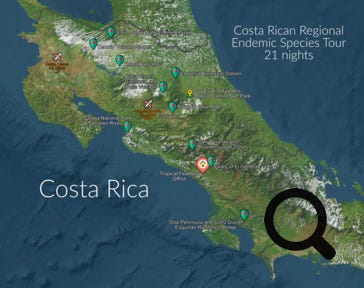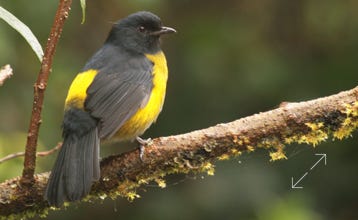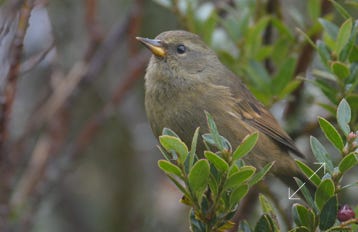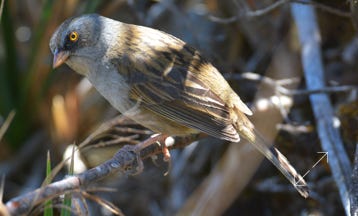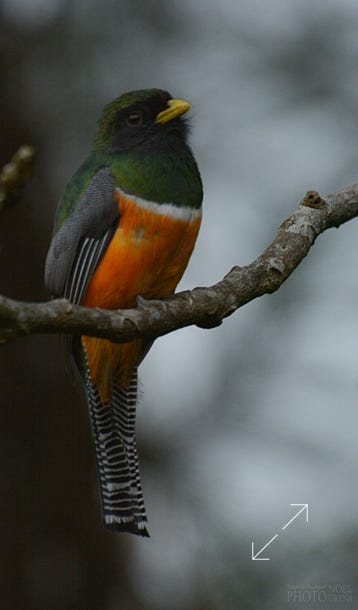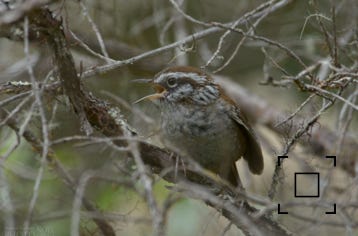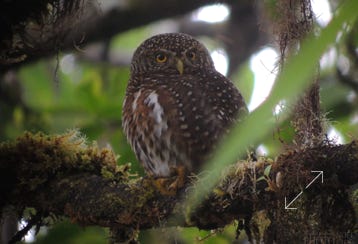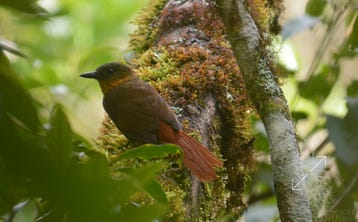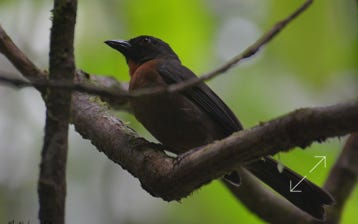Regional Endemic Species Tour

Regional Endemic Species Tour - 21 Nights
9 Different natural areas
Costa Rica offers over a hundred regional endemic species of birds. Since the geological formation of the Central American, particularly what today is Costa Rica and the western portion of Panama, the isthmus became a paradise for colonization and evolution of species. Our Regional Endemic Tour intends to provide birders with the opportunity to come and fully explore our country and focus on endemics. Like any of our other tours we would admire all nature encountered during this tropical journey. The trip is a length of 21 nights, however we can always custom design a shorter or longer tour.
Locations to be visited
2 nights - Poas Volcano, Vara Blanca and Cinchona foothills
3 nights - La Selva Biological Station - Sarapiqui rainforest - Caribbean lowlands
2 nights - Arenal Observatory Lodge - rainforests of northern region, Arenal Volcano environs
2 nights - Natural Lodge Caño Negro, Caño Negro Wildlife Refuge
2 nights - Celeste Mountain Lodge, Tenorio Volcano slopes
2 nights -Cerro Lodge or Villa Lapas - Carara National Park and Tarcoles River environs
3 nights - Esquinas Rainforest Lodge - Piedras Blancas National Park and Osa Peninsula habitats.
1 night - Talari Lodge and Los Cusingos, Valley of El General, the land of Dr. Skutch
3 nights - Savegre Mountain Lodge, highlands of the Talamancan cloud forest
1 night - Bougainvillea Hotel - Central Valley - for the final night near the airport.
Day 1 - Arrive at Costa Rica, Poás Volcano Lodge
Depending on the time of arrival stay at Buena Vista Hotel for this first night or drive a bit more and reach Poás Volcano Lodge (ideal) to get into our first birding spot. Poás Volcano Lodge would be 1 hour and 15 minutes away from the airport and it is located on Vara Blanca Village along the continental divide of the Central Volcanic Range.
Day 2 - La Paz, Vara Blanca and Cinchona (B,L,D)
Today we explore the lush and wet foothills of La Paz Waterfall, Vara Blanca and Cinchona. Stay in Poás Volcano Lodge. Potential target species are: Black-bellied Hummingbird, Purple-throated Mountain-gem, Coppery-headed Emerald, White-bellied Mountain-gem, Prong-billed Barbet, Golden-bellied Flycatcher, Tawny-capped Euphonia, Orange-bellied Trogon, Black-and-yellow Silky-Flycatcher, Streak-breasted Treehunter, Sooty-faced Finch and Silvery-fronted Tapaculo. Other common species of the location are Emerald and Hepatic Tanagers, Northern Emerald-Toucanet, White-naped Brushfinch, Rufous-winged Tanager, Golden-browed Chlorophonia. Bare-shanked Screech-Owl and Dusky Nightjar can be seen at the lodge.
Day 3 - Birding en route, La Selva Biological Station (B,L,D)
Early birding around the grounds of Poás Volcano Lodge. Drive to La Selva, birding along the way, a chance to pick up some additional species of the area of Cinchona and Vara Blanca. Afternoon exploring La Selva Biological Station and surroundings for Sungrebe, Great Green Macaw, Snowy Cotinga, Plain-colored Tanager, Nicaraguan Seed-Finch, Bare-necked Umbrellabird, Black-throated Wren, Stripe-breasted Wren, Crimson-fronted Parakeet and occasionally Tawny-chested Flycatcher. Also enjoy a great collection of woodpeckers: Black-cheeked Woodpecker, Chestnut-colored Woodpecker, Cinnamon Woodpecker, Rufous-winged Woodpecker, Pale-billed Woodpecker and Lineated Woodpecker. Also Rufous Motmot, Broad-billed Motmot, White-whiskered Puffbird, Pied Puffbird and Long-tailed Tyrant.
Day 4 - La Selva Biological Station (B,L,D)
A full day exploring the rainforest and open areas of La Selva Biological Station. A wonderful trail system allows access to different habitats.
Day 5 - Braulio Carrillo National Park and Cope’s Feeders (B,L,D)
Drive from La Selva into Braulio Carrillo National Park. A loop trail into a dense tropical foothill rainforest reveals species like Sooty-faced Finch, Bare-necked Umbrellabird, Black-crowned Antpitta, Black-eared Wood-Quail, Blue-and-gold Tanager, Tawny-capped Euphonia, Snowcap, Prong-billed Barbet and Lattice-tailed Trogon. Other interesting birds can include White Hawk, Ornate Hawk-Eagle, Crested Eagle, Bat Falcon, Black-crested Coquette, Magenta-throated Woodstar, Ocellated Antbird, Dull-mantled Antbird, Zeledon’s Antbird. In the afternoon visit the extraordinary feeders at Cope’s house, a fantastic location for bird photography, explore for owl perches, and other interesting wildlife surprises in Cope’s vicinities. Stay in La Selva Biological Station.
Day 6 - To Arenal Volcano Region, Arenal Observatory Lodge (B,L,D)
Pick up a few more species from La Selva before beginning our drive towards Arenal Volcano Area. Afternoon exploring the roads in the vicinities of the Arenal Lake.
Day 7 - Birding open areas, trails and roads around Arenal Volcano Lodge (B,L,D)
A full day exploring Arenal Observatory Lodge’s trail system and neighboring roads with great chances for Thicket Antpitta, Magenta-throated Woodstar, Bare-necked Umbrellabird, Ocellated Antbird, Zeledon’s Antbird, Yellow-eared Toucanet, Lovely Cotinga, White-fronted Nunbird, Stripe-breasted Wren, Purplish-backed Quail-Dove, Rufous-winged Woodpecker, Three-wattled Bellbird, Canebrake Wren, Plain-colored Tanager, Black-crested Coquette, Ornate Hawk-Eagle, White Hawk, Orange-bellied Trogon, Black-throated Wren, Rufous-vented Ground-Cuckoo, Keel-billed Motmot, Song Wren and Sharpbill.
Day 8 - Birding en route to Caño Negro Wildlife Refuge (B,L,D)
After some morning birding around Arenal Volcano begin our drive towards Caño Negro National Wildlife Refuge. We will stay in Caño Negro Natural Lodge. During the drive look for Jabiru, Lesser Yellow-headed Vulture, Harris's Hawk, Bat Falcon, Ruddy-breasted Seedeater, Nicaraguan Seed-Finch, Green-breasted Mango, Pinnated Bittern, Red-breasted Meadowlark, White-throated Crake and depending on our arrival time to Caño Negro we might get a chance to pick up some nocturnal species like Great Potoo, Common Potoo and some owls along the way!
Day 9 - Caño Negro Wildlife Refuge (B,L,D)
An amazing full day of birding in Caño Negro Wetlands, two boat trips will take us into different wetland environments as we look for Nicaraguan Grackle, Nicaraguan Seed-Finch, Snowy Cotinga, Pied Puffbird, Yellow-breasted Crake, Agami Heron, Green Kingfisher, Rufous Kingfisher (and all the other Kingfishers of the continent), Sungrebe, Boat-billed Heron, Black-collared Hawk, Snail Kite, Jabiru, Mangrove Cuckoo. Caño Negro has fairly regular sightings of Jaguars.
Day 10 - To Celeste Mountain Lodge - Tenorio Volcano Slopes (B,L,D)
Early birding, breakfast then travel to Celeste Mountain Lodge. Birding is extraordinary here and mixed species flocks can be large and very productive. Potential target species are Lattice-tailed Trogon, Bare-necked Umbrellabird, Stripe-breasted Wren, White-throated Shrike-Tanager, Tawny-capped Euphonia. Additionally look for White-fronted Nunbird, Lovely Cotinga, Rufous-vented Ground-Cuckoo, Song Wren, White Hawk, Ornate Hawk-Eagle, Long-tailed Manakin, Tody Motmot, Keel-billed Motmot, Purplish-backed Quail-Dove, Violaceous Quail-Dove, Crested Owl and Spectacled Owl.
Day 11 - Trails and Roadsides by Celeste Mountain Lodge (B,L,D)
A full day exploring the area. The loop trails of Celeste Mountain Lodge offer great opportunities for Tody Motmot, Violaceous Quail-Dove, Purplish-backed Quail-Dove, Ocellated Antbird, Dull-mantled Antbird, Zeledon’s Antbird, Lattice-tailed Trogon, Yellow-eared Toucanet and Black-eared Wood-Quail. Open areas and forested roadsides offer chances for Lovely Cotinga, Central American Pygmy-Owl, White-tipped Sicklebill, and occasionally Snowcap. Depending on bird activity and timing we may be able to visit Heliconias Lodge’s trail system.
Day 12 - Birding en route, Cerro Lodge, Carara and Tárcoles (B,L,D)
Early birding then departure to Cerro Lodge on the Pacific coast. Birding along the way may produce Double-striped Thick-Knee, Rusty Sparrow, White-throated Magpie-Jay, Streak-backed Oriole, Spot-breasted Oriole and Lesser Ground-Cuckoo. Cerro Lodge is found in the vicinities of Carara National Park and Tárcoles River.
Day 13 - Explore Carara and Tárcoles River (B,L,D)
Explore the two main trails in Carara National Park. Roadsides around Cerro Lodge are also quite productive and ideal for photography. Explore the mangroves by boat and several other spots, roadsides, trails for Yellow-billed Cotinga, Mangrove Hummingbird, Mangrove Vireo, Northern Scrub-Flycatcher, Fiery-billed Aracari, Black-hooded Antshrike, Black-bellied Wren, Riverside Wren, Spot-crowned Euphonia and Costa Rican Swift. This is a great destination as well to see Scarlet Macaws, Yellow-naped Parrot, White-fronted Parrot, Orange-fronted Parakeet, Pacific Screech-Owl, Black-and-white Owl, Crane Hawk, Scrub Euphonia, Royal Flycatcher, Cinnamon Hummingbird, Blue-throated Goldentail, Mangrove Warbler, American Pygmy-Kingfisher, Mangrove Cuckoo, Rufous-browed Peppershrike, Ferruginous Pygmy-Owl, Pearl Kite, King Vulture, Red-capped Manakin and Orange-collared Manakin.
Day 14 - Birding en route, Esquinas Rainforest Lodge (B,L,D)
Early boat exploration on the Tárcoles River, then travel to Esquinas Rainforest Lodge located in the southern Pacific zone, just off Piedras Blancas National Park.
Day 15 and 16 - Birding Esquinas Rainforest Lodge’s Trails and nearby areas (B,L,D)
These two full days will allow us to thoroughly explore this wonderful area, ideal to get to know the Osa Peninsula’s or southern Pacific’s species. Potential species include: Black-cheeked Ant-Tanager, Fiery-billed Aracari, Turquoise Cotinga, Yellow-billed Cotinga, Orange-collared Manakin, Black-bellied Wren, Riverside Wren, Spot-crowned Euphonia, Costa Rican Swift, White-throated Shrike-Tanager and Crimson-fronted Parakeet. Other birds include: Blue-headed Parrot, Brown-throated Parakeet, Rusty-margined Flycatcher, Tiny Hawk, Slate-colored Seedeater, Ruddy-breasted Seedeater and Yellow-billed Cotinga. Also King Vulture, Black Hawk-Eagle, Spectacled Owl, Gray-headed Kite, Pearl Kite, Gray-headed Tanager, White-throated Shrike-Tanager, Striped Woodhaunter, Baird`s Trogon, Little Tinamou, Bronzy Hermit, Band-tailed Barbthroat, White-tipped Sicklebill and Scrub Greenlet.
Day 17: Birding en route, Talari Lodge in San Isidro de El General (B,L,D)
Early birding and travel to Talari Lodge, a few stops on the way. Birding the grounds of Talari in the afternoon, also roads in the valley are quite productive. Look for Turquoise Cotinga, Greenish Elaenia, Pale-breasted Spinetail, Speckled Tanager, Orange-billed Nightinagle-Thrush and Red-breasted Meadowlark. Tonight look for Tropical Screech-Owl and Common Potoo.
Day 18 - Birding Los Cusingos, travel to Savegre Mountain Lodge (B,L,D)
Explore several areas in Valley of El General, several roads and preserves such Los Cusingos of Dr. Skutch offer good opportunities to find: White-crested Coquette, Garden Emerald, Charming Hummingbird, Snowy-bellied Hummingbird, Baird´s Trogon, Fiery-billed Aracari, Golden-naped Woodpecker, Black-hooded Antshrike, Turquoise Cotinga, Yellow-billed Cotinga, Orange-collared Manakin, Black-bellied Wren, Riverside Wren, Spot-crowned Euphonia, Costa Rican Swift, White-throated Shrike-Tanager and Crimson-fronted Parakeet. Also Ruddy Woodcreeper, Bicolored Antbird, Ruddy Quail-Dove and Bicolored Hawk. In the afternoon, explore some middle to high elevations to ensure the sightings of Spangle-cheeked Tanager, Silvery-fronted Tapaculo, Golden-browed Chlorophonia, Black-cheeked Warbler, Yellow-winged Vireo, Golden-bellied Flycatcher, White-tailed Emerald and Red-fronted Parrotlet. Also good chance for Ornate Hawk-Eagle, White-winged Tanager, Speckled Tanager, Collared Trogon, Chestnut-capped Brushfinch, Red-faced Spinetail and Brown-capped Vireo.
Day 19 and 20 - San Gerardo de Dota, Savegre Mountain Lodge (B,L,D)
Two full days exploring San Gerardo de Dota, a magnificent cloud forest destination. Trails in the oak forest, roadside and open areas and gardens provide a fantastic opportunity for birding and photography. These location can produce species like Resplendent Quetzal, Golden-browed Chlorophonia, Black-thighed Grosbeak, Volcano Junco, Large-footed Finch, Yellow-thighed Brushfinch, Slaty Flowerpiercer, Spangle-cheeked Tanger, Sooty-capped Chlorospingus, Black Guan, Buff-fronted Quail Dove, Sulfur-winged Parakeet, Red-fronted Parrotlet, Bare-shanked Screech-Owl, Costa Rica Pygmy-Owl, Dusky Nightjar, Fiery-throated Hummingbird, White-throated Mountain-gem, Ruddy Treerunner, Streak-breasted Treehunter, Dark Pewee, Ochraceous Pewee, Black-capped Flycatcher, Golden-bellied Flycatcher, Yellow-winged Vireo, Silvery-throated Jay, Ochraceous Wren, Silvery-fronted Tapaculo, Wrenthrush, Timberline Wren, Black-faced Solitaire, Black-billed Nightingale-Thrush, Sooty Thrush, Long-tailed Silky-Flycatcher, Flame-throated Warbler, Collared Redstart, Black-cheeked Warbler and Peg-billed Finch.
Day 21: Birding in San Gerardo de Dota, return to San Jose, Bougainvillea Hotel (B,L,D)
Early birding in San Gerardo de Dota, lunch and begin return to San José. Stay at Bougainvillea Hotel. Some later afternoon birding in the hotel grounds may produce White-eared Ground-Sparrow, Rufous-capped Warbler, Blue-crowned Motmot and Squirrel Cuckoo.
Day 22 - Return home (B)
Transport to the airport.
The above itinerary includes:
Lodging in all locations based on double occupancy
All meals starting with breakfast on Day2 and ending with breakfast on Day22
Professional birding guide
Private transportation
Entrance fees to parks and reserves
Boat tours
Your list of the birds of Costa Rica
Bottled drinking water for the drives
* Tips and Alcoholic Drinks are not included within the price.
Price per person: US$ 8,357 / per person on double occupancy
The price of the trip can be adjusted according to the number of people in the group. Single occupancy rates can be supplied.
Questions?
Drop us a line we’re happy to hear from you.

